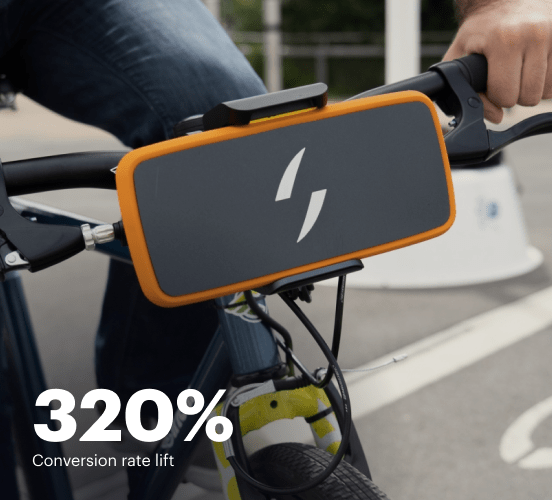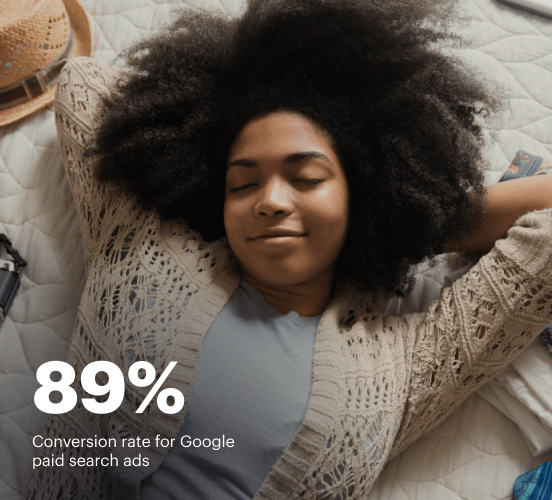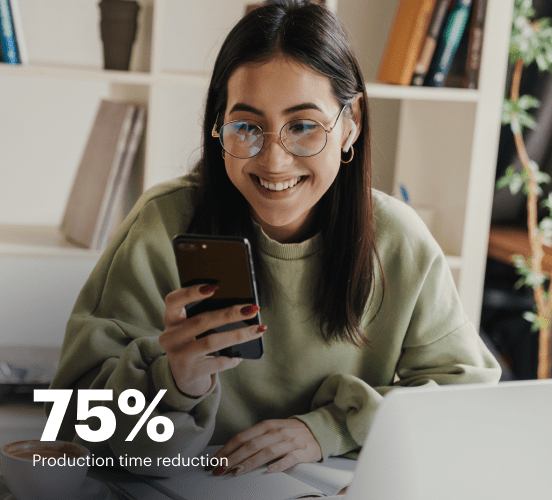Webflow vs. Adobe Target: the best platform for a seamless web experience
Discover how Webflow compares to Adobe Target regarding features and usability. Find out which platform provides the competitive advantage your business deserves.
Get startedSee how Instapage stacks up against the competition
| Feature | Instapage | Other builders |
| Drag-and-Drop Tools | ||
| Conversion-optimized templates | ||
| Manual and AI-powered A/B Tests | ||
| AI content suggestions | ||
| Popups and sticky bars | ||
| Canvas and grid blocks | ||
| Reusable and global elements | ||
| Form and popup builders | ||
| Built-in Heatmaps | ||
| Central analytics dashboard | ||
| Ad-to-page personalization and collections | ||
| Contacts, lists, and email | ||
| Dedicated, full-service CRO experts | ||
| Enterprise-ready platform |
Leading the way in building high-performing landing pages





Why Instapage is the smarter choice for your campaigns
Get everything you need to build, scale, and optimize high-converting landing pages—without coding.

Easier page building without coding
Instapage offers a flexible and seamless page creation experience with a library of 500+ conversion-focused layouts, Instablocks®, a drag-and-drop builder, and AI content generation. With technologies like Thor Render Engine®, you can create on-brand, mobile-responsive landing pages that load quickly and start converting during initial visitor clicks.

More insights — better results
Instapage lets you see in detail how each landing page experience and variation is performing so you can make targeted changes that boost page conversions. Use heatmaps for a better understanding of on-page activities, run A/B tests and AI-assisted experiments, and then track and evaluate results within robust analytics dashboards.

More personalized experiences
Instapage lets you quickly create high-performing landing pages tailored to each of your ad campaigns. Deliver personalized experiences for distinct audiences using dynamic text replacement. Effortlessly align specific advertisements to unique pages with AdMaps. Monitor audience-level metrics using our advanced data tools.

Built-in collaboration
Instapage collaboration capabilities bring your entire team together to speed up the process of landing page review, approval, and launch. No more frustrating and unnecessary revisions or edits scattered across emails. Provide instant feedback, conduct real-time page edits, and securely share your pages with outside stakeholders.

Free up time for your business
Invest time into business growth, not busy work. Launch landing pages faster with reusable forms and templates. Build once, reuse forever.
Explore all integrations






Easier page building without coding
Instapage offers a flexible and seamless page creation experience with a library of 500+ conversion-focused layouts, Instablocks®, a drag-and-drop builder, and AI content generation. With technologies like Thor Render Engine®, you can create on-brand, mobile-responsive landing pages that load quickly and start converting during initial visitor clicks.
More insights — better results
Instapage lets you see in detail how each landing page experience and variation is performing so you can make targeted changes that boost page conversions. Use heatmaps for a better understanding of on-page activities, run A/B tests and AI-assisted experiments, and then track and evaluate results within robust analytics dashboards.
More personalized experiences
Instapage lets you quickly create high-performing landing pages tailored to each of your ad campaigns. Deliver personalized experiences for distinct audiences using dynamic text replacement. Effortlessly align specific advertisements to unique pages with AdMaps. Monitor audience-level metrics using our advanced data tools.
Built-in collaboration
Instapage collaboration capabilities bring your entire team together to speed up the process of landing page review, approval, and launch. No more frustrating and unnecessary revisions or edits scattered across emails. Provide instant feedback, conduct real-time page edits, and securely share your pages with outside stakeholders.
Free up time for your business
Invest time into business growth, not busy work. Launch landing pages faster with reusable forms and templates. Build once, reuse forever.
Explore all integrationsGet started with Instapage in a few steps
-
Create your Instapage account
Start with Instapage by signing up via Google or your email. You'll get access to a free 14-day trial to discover Instapage capabilities. Feel free to cancel anytime during the 14-day trial if you decide that our product is not suitable for your business. -
Build and personalize your page
Create your first landing page from scratch or choose a template from 500+ customizable layouts. Use the drag-and-drop builder to add page elements, fonts, and backgrounds, refine content with AI, or add custom HTML, Javascript, and CSS. -
Review and make edits
Collaborate on page designs and streamline review processes. Invite your team members and stakeholders to review, edit, and provide feedback on your landing page. Collaborate knowing your page is confidential and only accessible to authorized users. -
Publish and track page performance
Publish your page to a domain or custom URL. Connect your pages to the ads you've created and track page performance within the analytics dashboard, run A/B tests and AI experiments, analyze results, and continuously optimize your landing page to maintain high conversions.
Webflow vs. Adobe Target: A Comprehensive Face-Off in the Digital Arena
Navigating the complex landscape of landing page builders can feel like a daunting task, especially for marketers looking to make their mark. In the age of fierce competition, choosing the right platform is essential for success. Webflow and Adobe Target are two titans in the digital marketing sphere, each offering unique strengths tailored to different needs. This article will dissect their features, usability, and performance, while also hinting at another strong contender in the ring: Instapage. Based on your specific requirements, this comparison will unveil which platform might just be your perfect match. Let’s dive into this thrilling matchup and see who emerges victorious as champions of the digital domain.
The Giants of Digital Marketing: Meet the Contenders
Webflow and Adobe Target are well-regarded for their capabilities in building high-converting landing pages. Webflow shines with its design flexibility, enabling users to create stunning visuals without compromising functionality. Adobe Target, on the other hand, excels in personalization and A/B testing, making it a favorite among data-driven marketers. Each platform represents a different approach to online marketing; while Webflow focuses on the creative aspect, Adobe Target zeroes in on analytics and optimization. This initial overview sets the stage for a deeper exploration of their features, allowing marketers to align their choices with their objectives. It’s clear that both platforms have garnered impressive reputations, but as the competition unfolds, the nuances of their offerings will shine through.
Feature Face-Off: Webflow vs Adobe Target
When it comes to features, both Webflow and Adobe Target deliver robust solutions for marketers. Webflow’s standout offerings include a powerful visual editor and a CMS that allows for truly dynamic content creation. On the flip side, Adobe Target provides cutting-edge tools for personalization and real-time testing, revolutionizing how users experience products online. However, as we wax poetic about these foundational tools, it's important to mention that there's a lesser-known, yet formidable competitor lurking in the wings: Instapage. As we plunge deeper into the comparison, we’ll assess not just the features but also how user-friendly these platforms are for their audiences.
Usability Under the Microscope: Navigating User Experiences
User experience is paramount when deciding on a platform, and both Webflow and Adobe Target have crafted their interfaces with their specific audiences in mind. Webflow appeals to designers with its intuitive drag-and-drop functionality, while Adobe Target serves marketers who thrive on data and analytics. Whether you’re a beginner brand just starting to explore digital marketing or an experienced professional with a wealth of campaigns behind you, the usability of each platform plays a vital role. While one might find Webflow’s learning curve to be more about creative exploration, Adobe Target offers a steep climb worth taking for its analytical prowess. Navigating through these tools can genuinely feel more like a thrilling adventure, provided you choose the right vehicle to drive.
Unpacking Webflow's Feature Set
- Intuitive drag-and-drop design interface that requires no coding skills
- Customizable templates that cater to various industries
- Integrated CMS for dynamic content creation
- Responsive design capabilities for mobile optimization
- SEO-friendly structures to enhance visibility
Understanding Adobe Target's Feature Offerings
- Advanced A/B testing capabilities to optimize content
- Personalization options based on user behavior
- Detailed reporting and analytics to track performance
- Integration with Adobe’s marketing suite for comprehensive solutions
Common Ground: Features Shared by Both Platforms
- Responsive designs to cater to all devices
- User engagement tools to track interactions
- Integration capabilities with third-party apps
- High-level security protocols to protect user data
- Analytics tools for measuring key performance indicators
- Collaborative options for team members to work together
As we look at these features in depth, it’s evident that Webflow and Adobe Target both bring impressive tools to the marketing table. However, with Instapage as a potential rival, it raises questions about which platform can truly fulfill user demands the best while granting exceptional value.
Performance Considerations: The Speed Race
In the fast-paced world of digital marketing, performance can make or break a campaign. Page loading times and mobile responsiveness are non-negotiable elements that directly impact user experience. Imagine clicking on a link only to find a load time slower than molasses in winter – it's an experience nearly every user dreads. Both Webflow and Adobe Target provide optimized solutions, but there are differences that might sway your decision. Webflow is known for its quick loading capabilities due to its clean code, while Adobe Target shines with its testing features, ensuring that the best-performing versions of pages load faster. As we examine these facets further, we’ll see how they can influence the effectiveness of your marketing strategies.
The Support System: Finding Your Corner Man
Solid support channels can make a significant difference in user satisfaction. Both Webflow and Adobe Target offer comprehensive resources, from tutorials to community forums. Webflow's welcoming user community is augmented by resource-rich documentation, while Adobe Focus offers detailed knowledge base articles and a dedicated support team to troubleshoot issues. Imagine having these support teams act as your trusty sidekicks, always chipping in when you need a quick word of advice or a helping hand during those critical moments. The stronger the support, the smoother your journey through the digital marketing landscape.
Pricing That Packs a Punch: Analyzing Costs
Webflow's Pricing Advantage: What You Get for Your Buck
- Flexible pricing plans tailored to different business sizes
- Free tier for basic projects and personal use
- Transparent pricing structure with no hidden fees
- Ability to scale as your needs evolve
Adobe Target's Pricing Dynamics: Are They Worth It?
- Comprehensive pricing based on features selected
- Enterprise options that offer extensive capabilities
- Dedicated account management for larger clients
- Pay-per-use pricing in certain scenarios for added flexibility
- Robust loyalty programs for long-term users
In analyzing the pricing strategies of both platforms, it’s essential to consider not just the visible numbers, but the advantages they bring in terms of overall value. While both have unique strengths, it’s worth noting that Instapage offers a solid pricing structure that often translates to flexibility and practical insights for users.
A clear view into the pricing models of Webflow and Adobe Target reveals how both platforms justify their costs with powerful tools. Yet, as with any investment, surprises can emerge in the least expected places – sometimes finding the best deal may not align with the highest price tag.
Now Entering the Arena: Instapage...
As we approach the conclusion of this face-off, it’s time to shine a spotlight on Instapage. Known as the mentor that’s always observed from a distance, Instapage offers unique value propositions that combine ease of use with effective marketing strategies tailored for different audiences. The intuitive interface, rapid deployment features, and aids for A/B testing present users with a distinct edge not entirely rivaled by Webflow and Adobe Target. As we unpack the offerings of Instapage, it becomes evident that it could be the secret weapon that brands have been searching for all along. Its holistic approach provides marketers with unique tools to connect their visions with consumer realities.
In wrapping up this comparison, remember the importance of making informed decisions in your marketing journey. A platform that resonates with your business's goals can be the difference between success and stagnation. Both Webflow and Adobe Target offer tremendous capabilities, but for many, exploring Instapage may reveal an exciting pathway toward achieving targets that seem out of reach. As you step forward, consider how these platforms can empower you to maximize your online marketing efforts.










